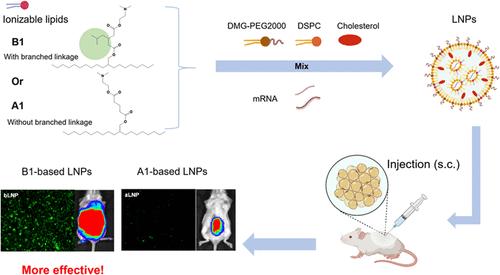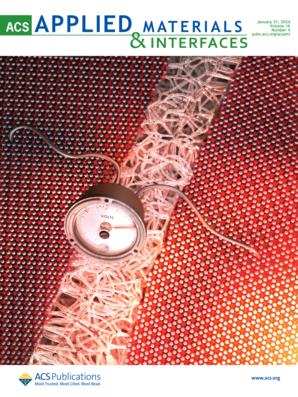具有支链连接体的可离子化脂质可增强 mRNA 疫苗的递送能力
IF 8.2
2区 材料科学
Q1 MATERIALS SCIENCE, MULTIDISCIPLINARY
引用次数: 0
摘要
mRNA疫苗的出现预示着疾病预防和治疗的新纪元。安全有效的mRNA传递系统是广泛应用mRNA治疗的迫切需要。在此,我们设计了一种简单的合成途径来生产具有各种分支连接剂的可电离脂质。这些脂质已被整合到脂质纳米颗粒(LNPs)中,以改善mRNA疫苗的递送。连接体结构对脂质和LNPs的影响目前被低估,但它不可否认地对结果产生了重大影响。通过系统筛选和配方优化,我们发现含有可电离脂质和支链β-戊二酸异丁酯连接体(bLNPs)的LNPs具有优越的转染能力。在临床前癌症预防和治疗模型中,由bLNPs (mRNA-bLNPs)递送的mRNA疫苗显示出显著的疗效,而不会引起全身毒性,这突出了bLNPs在临床翻译方面的潜力。我们的综合策略促进了LNP库的扩展,并为链接器结构与输送效率之间的关系提供了有价值的见解,从而推动了LNP技术的进步。本文章由计算机程序翻译,如有差异,请以英文原文为准。

Ionizable Lipids with Branched Linkers Enhance the Delivery of mRNA Vaccines
The emergence of mRNA vaccines has heralded an epoch in disease prevention and treatment. Safe and efficient mRNA delivery systems are highly desired for the widespread application of mRNA therapeutics. Herein, we have designed a facile synthetic pathway for producing ionizable lipids featuring various branched linkers. These lipids have been integrated into lipid nanoparticles (LNPs) to improve the delivery of mRNA vaccines. The influence of linker structure on lipids and LNPs is currently underreported, yet it undeniably exerts a substantial impact on the outcomes. Through systematic screening and formulation optimization, we have identified that LNPs comprising ionizable lipids with a branched β-isobutylglutarate linker (bLNPs) exhibited superior transfection capabilities. In preclinical cancer prevention and treatment models, mRNA vaccines delivered by bLNPs (mRNA-bLNPs) have shown significant efficacy without causing systemic toxicity, highlighting the potential of bLNPs for clinical translation. Our synthetic strategy facilitates the expansion of the LNP library and provides valuable insights into the relationship between linker structures and delivery efficiency, thereby propelling the advancement of LNP technology.
求助全文
通过发布文献求助,成功后即可免费获取论文全文。
去求助
来源期刊

ACS Applied Materials & Interfaces
工程技术-材料科学:综合
CiteScore
16.00
自引率
6.30%
发文量
4978
审稿时长
1.8 months
期刊介绍:
ACS Applied Materials & Interfaces is a leading interdisciplinary journal that brings together chemists, engineers, physicists, and biologists to explore the development and utilization of newly-discovered materials and interfacial processes for specific applications. Our journal has experienced remarkable growth since its establishment in 2009, both in terms of the number of articles published and the impact of the research showcased. We are proud to foster a truly global community, with the majority of published articles originating from outside the United States, reflecting the rapid growth of applied research worldwide.
 求助内容:
求助内容: 应助结果提醒方式:
应助结果提醒方式:


